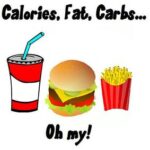Consumers have been told that excess sugar, carbs, trans fats and other ingredients in foods are bad for us. Food companies have responded by advertising their foods as “Free.” But are they, really?
In this article I will discuss these and other common labels and describe what exactly they mean. Never be fooled by clever wording again!
Calorie Free- Some foods and drinks, such as diet coke and sugar free gum are labeled as “Calorie Free.” The nutrition label on the back even says “0 calories” most of the time. But are these foods and drinks really free of calories? No. The Food and Drug Administration (FDA) requires that nutrition labels that claim “calorie free” much have less than 5 calories per serving. Eight ounces of diet cola actually has about 2 1/2 or 3 calories. While this number is minuscule, it is still deceiving.
Fat Free- Another common claim on food packages; are these “fat free” foods really fat free? Well, maybe not. The Food and Drug Administration requires that a food be less than .5 gram of fat per serving to be considered “fat free.” This .5 can actually add up over the course of a day. If you eat 4 servings of a food labeled as being “fat free,” but really has .5 gram of fat, you will consume 2 grams of fat more than you thought. For someone trying to eat a very low fat diet, these “hidden” fat grams can make a difference.
Saturated Fat Free or Trans Fat Free- These fats basically follow the same guidelines as general fat, as far as food labeling goes. To be considered “saturated fat free” or “trans fat free,” a food must contain less than .5 gram of the fat per serving. These hidden fats can be even more dangerous than the general fat. trans fats, for example, are not recommended in any quantity. If you think you are eating foods free of trans fats, but you really are, you may run into health problems and not know why.
These are just some of the most common claims made by food companies. While these are not lies made to consumers, they are very deceiving. Many Americans are trying to watch what they eat and consume healthier foods when they can. Food companies make it really difficult for us.
But what can we do? One strategy is to become better educated in nutrition and nutrition labels. The FDA requires that all ingredients in a food or drink be listed in the “ingredients” section. This is one place where you can pick up on these missing pieces to the regular label.
The easiest “hidden fat” to find is trans fats. If a food has hydrogenated oils or partially hydrogenated oils then it has trans fats, in some amount. The best bet is to simply stay away from any food containing these ingredients.
The internet is a great resource for nutritional information. There are websites out there with nutritional information on just about any food or drink imaginable. These websites will give you the 2.5 calories and the .4 grams of fat that the nutrition label doesn’t. One accurate and user-friendly website for this is www.fitday.com. Refer to my article on Top 5 Online Resources for Nutritional Information for more resources.
Armed with the correct information and a little nutrition-label reading know-how, you, too can learn to better understand these food packages.
Sources:
http://www.associatedcontent.com/article/182355/top_5_online_sources_for_nutritional.html
www.caloriecontrol.org
www.fitday.com



